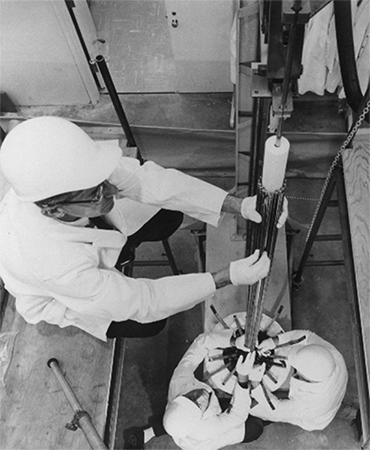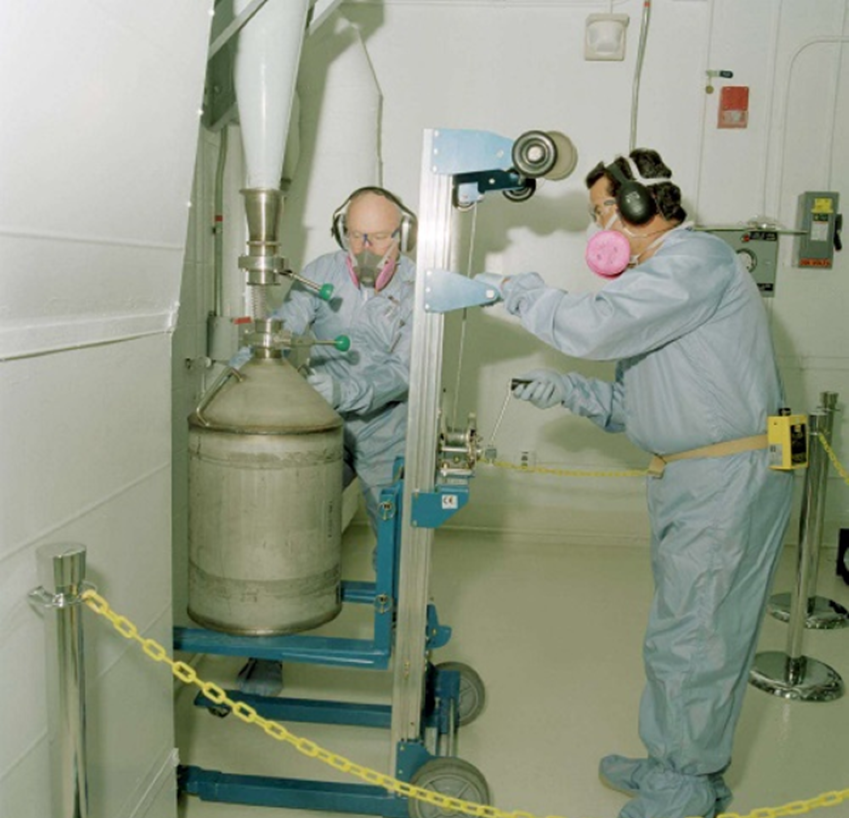
Beryllium (Be) is a silver-gray metallic element used in a variety of industrial applications including X-ray transmission windows, missile components, nuclear reactor neutron reflectors, nuclear weapons, fuel containers, precision instruments, navigational systems, heat shields, mirrors, high-speed computers, and audio components.
Exposure to beryllium fumes or dust through inhalation or contact with broken skin can lead to a range of responses from Beryllium sensitization to chronic beryllium disease (CBD), and even lung cancer. CBD can be effectively treated but is not curable. While most people exposed to beryllium won’t become sensitized, understanding the health effects and employing appropriate safety protocols are critical as the use of Beryllium-containing materials ramps up to enable the Department of Energy (DOE) mission.
Sensitization to beryllium can be assessed with a blood test called the Beryllium Lymphocyte Proliferation Test (BeLPT). Given the potential health consequences associated with beryllium exposure, the U.S. Code of Federal Regulations (CFR) Title 10, Part 850 Chronic Beryllium Disease Prevention Program requires DOE sites to inventory and assess beryllium exposure hazards to determine whether employees are at risk for CBD.
Beryllium-Associated Worker Registry

The DOE Domestic and International Health Studies supports the operation of a surveillance registry of current workers who are exposed to beryllium in their current job, or may have been exposed to beryllium in the past from work conducted at a DOE site. The goal of the registry is to determine the incidence and prevalence of beryllium sensitization and chronic beryllium disease (CBD). The data will be analyzed to better understand CBD and to identify those at risk. Another goal is to monitor and evaluate the effectiveness of DOE's Chronic Beryllium Disease Prevention Program.
As a means of providing a better user experience with this tool, the BAWR program has transitioned from presenting data in a paper-based annual report to an interactive digital format, or a Dashboard. This transition from paper to digital format is intended to allow for interaction with and visualization of data contained in the Registry.
The BAWR Dashboard contains the same sections of data, graphs, tables, and figures as the paper-based annual reports but is presented within the Dashboard format.
Archived Reports
- Beryllium-Associated Worker Registry Dashboard, (2022)
- Beryllium-Associated Worker Registry Dashboard, (2021)
- Beryllium-Associated Worker Registry Dashboard, (2020)
- Beryllium-Associated Worker Registry Dashboard, (2019)
- Beryllium-Associated Worker Registry Dashboard, (2018)
- 2017 Beryllium-Associated Worker Registry Summary
- 2016 Beryllium-Associated Worker Registry Summary
- 2015 Beryllium-Associated Worker Registry Summary
- 2014 Beryllium-Associated Worker Registry Summary
- 2013 Beryllium-Associated Worker Registry Summary
- 2012 Beryllium-Associated Worker Registry Summary
- 2011 Beryllium-Associated Worker Registry Summary
Other Resources
- Chronic Beryllium Disease Prevention Program - provides information on DOE rules and guides for CBD prevention.
- Beryllium-Associated Worker Registry Data Collection and Management Guidance - DOE Technical Standard DOE-STD-1187-2007, June 2007 establishes procedures used to collect, analyze and report data.
- DOE-SPEC-1142-2001, April 2001 - which provides a purchase specification for a screening test used in medical surveillance programs.
- DOE's Former Worker Medical Screening Program - Provides information on medical surveillance of former workers who are retired or separated from employment at a DOE site.
For further information on the Beryllium-Associated Worker Registry, please contact: Kali Crosby
Beryllium Biobank (Formerly Beryllium Bio-Repository)
Because there is not yet an animal model to study the disease, current research to improve the understanding, diagnosis, and treatment of beryllium-related diseases depends entirely on studies of collected human cells and tissues. An expert committee of clinicians and scientists from National Jewish Health, University of Pennsylvania Hospital, University of California Los Angeles, University of California San Francisco, University of Colorado, National Institute for Occupational Safety and Health, and the Mayo Clinic worked to complete Phase 1 of the Beryllium BioBank initiative (the Beryllium Bio-Repository) focused on development of a standard protocol for data collection and management. The initiative then evolved into the Beryllium BioBank (Phase 2) managed by National Jewish Health.
The goal of the Beryllium BioBank was to archive important clinical specimens and related data to ensure their availability for research to improve our understanding of beryllium-related disease. Donations of blood and tissue samples were obtained from individuals diagnosed either with CBD or BeS, as well as matching control individuals (those exposed to beryllium but without sensitivity or disease). All participants in this program are volunteers and have given their written consent for the use of their donated bio-samples. Phase 2 (tissue donations and storage) involved the participation of the five clinical centers which conducted clinical evaluations for the majority of current and former DOE workers suspected of having CBD: National Jewish Medical and Research Center, University of Pennsylvania Hospital, East Tennessee Pulmonary Associates, University of California Los Angeles, and University of California San Francisco. In addition, other medical information related to CBD and BeS, occupational work histories, and exposure information was collected. All biological specimens and clinical data were de-identified at the clinical centers before being banked and stored.
For further information on the Beryllium BioBank, please contact Dr. Joey Zhou.
To apply for use of the data, visit Beryllium BioBank.

